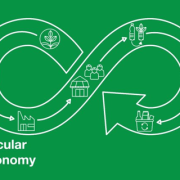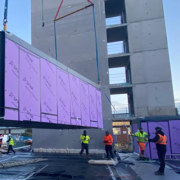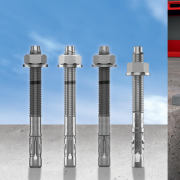CARDIFF INSTALLS FIRST OF THEIR KIND GREEN, AFFORDABLE HOMES
- Wates Residential and Cardiff Council lowering nine modular homes onsite at Crofts Street, Plasnewydd
- First time this method of offsite construction used for permanent family homes in city
- Homes to be made available to residents on Council’s housing waiting list in just five weeks
Wates Residential and Cardiff Council are today installing Cardiff’s first sustainable, modular homes, at a brownfield site on Crofts Street, Plasnewydd, as the Council increases its provision of affordable homes for local residents on housing waiting lists and those most in need.
The nine two-bedroom properties, which have been built offsite using modern methods of construction (MMC), will be lowered onto their final position on-site with all the groundworks and external hard and soft landscaping completed.
This is the first time this method of offsite construction has been used by Cardiff Council to deliver permanent homes for families living in the city. The method not only enables the units to be built and installed in record time, but will also use the latest technology and construction materials to create net-zero carbon buildings that are 90% more energy efficient than standard homes built to current Building Regulations. They will be extremely airtight, meaning they are well insulated and residents will see huge savings on their bills[1].
In recognition of their environmental credentials, the homes have achieved Grade A in Predicted Energy Efficiency and Environmental Impact (CO2) ratings. The houses will have solar panels on their roofs and MEV Heat Recovery with electric heating elements, so that they will not be required to connect to the mains gas service and will emit significantly less CO2 than a standard home.
Offsite construction also creates less disruption to residents, as the overall build programme and onsite activity is greatly reduced, with the units being designed to the same style as the terraced housing in the area.
Once the units are installed, all services will be connected, followed by the installation of electricity and plumbing, with the Council making the homes available to tenants on its existing housing waiting list in just five weeks.
Edward Rees, Wates Residential Regional Director, Cardiff, said:
“It is incredible to see this unused plot of land transformed into affordable homes. We care about the communities in which we operate and aim to design and build homes that put local people first. And, by using innovative modern methods of construction, we’re not only able to deliver these units just five weeks from now, but we are also creating homes that will support Cardiff and its residents in reducing their energy consumption and contributing to a more sustainable future.
“We are committed to eliminating waste and carbon from our operations by 2025, well ahead of the Government’s own environmental targets, and we’re working collaboratively with customers, supply chain and joint venture partners to find better and more innovative ways to reduce waste, reduce energy consumption and enhance the natural environment.”
Cllr Lynda Thorne, Cabinet Member for Housing and Communities at Cardiff Council, who attended the lowering of the units today, said:
“The installation of the modular units at Crofts Street is a very exciting day for us as we have eagerly been awaiting their arrival. Increasing the availability of affordable housing for people in Cardiff is a high priority for the Council, but we also want to make sure that the new homes we are delivering are good quality properties that are as ‘green’ as they possibly can be for the benefits of our tenants by reducing fuel poverty and the benefit of our wider population, because it’s the right, sustainable thing to do.
“Right across our housing development programme, we are working on getting as close to zero carbon as we can with innovative construction methods and technologies that surpass current building regulations, minimise environmental impact and reduce ongoing running costs for tenants.
“I’m delighted that the first new tenants in the development will be in before Christmas and they can begin enjoying living in their new Cardiff Living homes so soon.”
The homes are part of Wates Residential’s Cardiff Living partnership with Cardiff Council to deliver 1,500 new homes across 40 sites in the city over a 10-year period, including affordable homes for rent and sale, supported accommodation and more accessible and adaptable homes for older people.













 smaller spacings than when using anchors. They are also easy to use and install, with no specialist skills required, which can be a big time-saver on site.
smaller spacings than when using anchors. They are also easy to use and install, with no specialist skills required, which can be a big time-saver on site.
